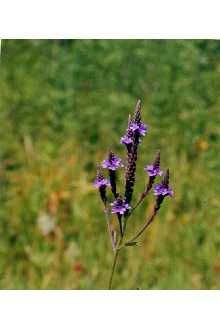New Moon Nurseries

Perennial for wet meadows, stream banks, fields, and waste areas. Photo credit: Jennifer Anderson @ USDA-NRCS PLANTS Database
Verbena hastata
Blue vervain
Native to North America
FIRST IMPRESSIONS: Verbena hastata is a clumping perennial with stiff erect squarish stems. Leaves are opposite with coarse teeth. In summer, plants are topped by narrow spikey panicles of small tubular purple flowers. Plants thrive in full or part sun in moist or wet mucky soils.
HABITAT & HARDINESS: Verbena hastata ranges through most of the contiguous United States and into the southern Canadian provinces.
This species is indigenous to moist meadows, floodplain prairies, open bottomland woods, moist thickets, edges of rivers, creeks, ponds, sloughs and ditches, disturbed pastures and fence rows. Plants adapt to disturbed wetlands or moist higher quality habitats.
Plants are hardy from USDA Zones 3-9.
PLANT DESCRIPTION: Verbena hastata is a slender upright perennial with multiple stems and short rhizomes.
Stems are square and green or reddish with white hairs. The leaves are opposite with short petioles.
Leaf blades are lance shaped with prominent veins. They are about 6” long and 1” wide with coarsely toothed edges and pointed tips.
For about 6 weeks in mid to late summer stems are terminated by narrow spike-like panicles. The foot-long panicles are candelabra-like and each consists of numerous ¼” blue-purple florets. The florets are tubular with 5 spreading lobes and long grayish or reddish sepals.
Mature inflorescences are 1’ long with florets toward the top and persistent sepals full of small reddish brown nutlets below.
Plants grow up to 2-6’ tall with 1-2’ spread.
CULTURAL & MAINTENANCE NEEDS: Verbena hastata thrives in full or part sun and moist or wet soil. Plants tolerate moderate salt levels, loamy or wet mucky soils and temporary standing water.
This species is fairly pest resistant. The bitter foliage is unpalatable to most herbivores although tender young growth can be nibbled by cottontail rabbits.
Plants often form colonies in the wild from rhizomes and self-seeding. In garden situations, tip pruning or deadheading can prevent excessive seeding and encourage a branched bushier form.
LANDSCAPE USES: This is a good choice for a Wildlife Garden, border of a Water Garden, or wet Meadow. Plants are also used as Butterfly Nectar Plants or as part of a Grouping or Mass Planting. Verbena hastata has Showy Blooms and is appropriate for Cottage Gardens, Deer Resistant Plantings, Low Maintenance Plantings, Rain Gardens, Stormwater Management projects and Perennial Borders.
COMPANION & UNDERSTUDY PLANTS: Try pairing Verbena hastata with Aster puniceus, Caltha palustris, Carex bicknellii, Eupatorium maculatum, Iris versicolor, Lobelia. siphilitica, Panicum virgatum, Scirpus pungens, Scirpus validus or Spartina patens.
Physostegia virginiana has similar candelabra shaped inflorescences and similar cultural needs and could be substituted in some situations.
TRIVIA: The nectar and pollen of Verbena hastata attracts a wide variety of native bees, honey bees, beneficial wasps, pollinating flies, small butterflies, skippers and moths. Caterpillars of the verbena moth and common buckeye butterfly feed on the leaves. Cottontail rabbits nibble young foliage and cardinals, sparrows and juncos forage for the seed.
This species is sometimes called Swamp Verbena due to its tolerance of wet soggy sites and Simpler’s Joy due to its traditional medicinal uses.
The generic name Verbena is Latin for “sacred plant”. In the days of yore, drinking “sacred” vervain tea was said to ward off vampires. The specific epithet means “spear shaped” due to the lanceolate leaves.
Height:
2-6 ftSpread:
1-2 ftSpacing:
18-24 inUSDA Hardiness Zone:
3-9Bloom Color:
PurpleVerbena hastata Characteristics
Attracts Wildlife
- Butterflies
- Pollinators
Attributes
- Favorite
- East-Coast Native
- Rain Garden
- Dried Flower
- Cut Flower
- Bog
- Naturalizing
- Long Blooming
Exposure
- Full Sun to Partial Shade
Flowering Months
- August
- July
Foliage Color
- Green
Growth Rate
- Fast
Salt Tolerance
- Medium
Season of Interest (Foliage)
- Summer
- Spring
Soil Moisture Preference
- Moist to Wet
Interesting Notes:
For more information on this plant, visit the USDA PLANTS Database: http://plants.usda.gov/java/profile?symbol=VEHA2